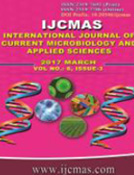


 National Academy of Agricultural Sciences (NAAS)
National Academy of Agricultural Sciences (NAAS)

|
PRINT ISSN : 2319-7692
Online ISSN : 2319-7706 Issues : 12 per year Publisher : Excellent Publishers Email : editorijcmas@gmail.com / submit@ijcmas.com Editor-in-chief: Dr.M.Prakash Index Copernicus ICV 2018: 95.39 NAAS RATING 2020: 5.38 |
A field experiment was conducted during rabi season of 2011-12 and 2012-13at C.S. Azad University of Agriculture and Technology, Kanpur to find out the combined effect of organic and inorganic fertilizers on grain yield, fertilizer use efficiency and grain quality of wheat crop. The treatments were -Control (T1), RDF (150:60:40 NPK Kg/ha) (T2),125% RDF (T3), RDF + Vermicompost (VC) at 2.5 t/ha (T4), RDF + VC at 5t/ha (T5), RDF + FYM at 5t/ha (T6), RDF + FYM at 10t/ha (T7), RDF + VC at 2.5 t/ha + Azotobacter (T8), RDF + FYM at 5t/ha + Azotobacter (T9), and RDF + VC at 2.5 t/ha + FYM at 5 t/ha + Azotobacter (T10). Result showed that the treatment T10 produced higher grain yield than the other treatments. The higher yield led to higher NPK uptake by wheat. Further, the available NPK and organic carbon (%) content of soil also increased with integration of organic and inorganic fertilizer along with bio-fertilizer strain over control. Different fertilizer- use efficiencies were significantly improved with the application of manures, chemical fertilizers and bio-fertilizer over control as well as chemical fertilizer alone. All the fertilizer use efficiency was maximum in treatment T10followed by treatment T9 and the minimum value was quantified in T3, T2, T1 (control). The highest grain protein content was obtained from the application of organic and inorganic fertilizer along with azotobacter and lowest from control as well as NPK fertilizer alone.
 |
 |
 |
 |
 |